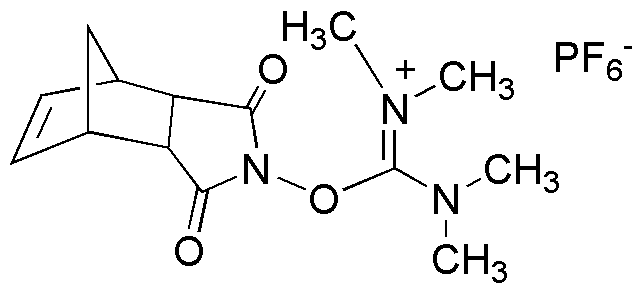O-(endo-5-Norbornene-2,3-dicarboximido)-N,N,N’,N’-tetramethyluronium hexafluorophosphate is widely utilized in research focused on:
- Polymer Chemistry: This compound serves as a highly effective initiator for polymerization reactions, enabling the synthesis of advanced materials with tailored properties, which is crucial in industries like packaging and automotive.
- Organic Synthesis: It acts as a reagent in various organic transformations, facilitating the formation of complex molecules. This is particularly beneficial in pharmaceutical development, where precise chemical structures are essential.
- Photolithography: In the semiconductor industry, it is used in photoresist formulations, allowing for the creation of intricate circuit patterns on chips, which enhances the performance of electronic devices.
- Bioconjugation: The compound can be employed in the conjugation of biomolecules, improving the efficacy of drug delivery systems and diagnostic tools in medical research.
- Environmental Applications: It is also being explored for use in the development of materials that can capture and degrade pollutants, contributing to cleaner technologies and sustainable practices.
General Information
Properties
Safety and Regulations
Applications
O-(endo-5-Norbornene-2,3-dicarboximido)-N,N,N’,N’-tetramethyluronium hexafluorophosphate is widely utilized in research focused on:
- Polymer Chemistry: This compound serves as a highly effective initiator for polymerization reactions, enabling the synthesis of advanced materials with tailored properties, which is crucial in industries like packaging and automotive.
- Organic Synthesis: It acts as a reagent in various organic transformations, facilitating the formation of complex molecules. This is particularly beneficial in pharmaceutical development, where precise chemical structures are essential.
- Photolithography: In the semiconductor industry, it is used in photoresist formulations, allowing for the creation of intricate circuit patterns on chips, which enhances the performance of electronic devices.
- Bioconjugation: The compound can be employed in the conjugation of biomolecules, improving the efficacy of drug delivery systems and diagnostic tools in medical research.
- Environmental Applications: It is also being explored for use in the development of materials that can capture and degrade pollutants, contributing to cleaner technologies and sustainable practices.
Documents
Safety Data Sheets (SDS)
The SDS provides comprehensive safety information on handling, storage, and disposal of the product.
Product Specification (PS)
The PS provides a comprehensive breakdown of the product’s properties, including chemical composition, physical state, purity, and storage requirements. It also details acceptable quality ranges and the product's intended applications.
Certificates of Analysis (COA)
Search for Certificates of Analysis (COA) by entering the products Lot Number. Lot and Batch Numbers can be found on a product’s label following the words ‘Lot’ or ‘Batch’.
*Catalog Number
*Lot Number
Certificates Of Origin (COO)
This COO confirms the country where the product was manufactured, and also details the materials and components used in it and whether it is derived from natural, synthetic, or other specific sources. This certificate may be required for customs, trade, and regulatory compliance.
*Catalog Number
*Lot Number
Safety Data Sheets (SDS)
The SDS provides comprehensive safety information on handling, storage, and disposal of the product.
DownloadProduct Specification (PS)
The PS provides a comprehensive breakdown of the product’s properties, including chemical composition, physical state, purity, and storage requirements. It also details acceptable quality ranges and the product's intended applications.
DownloadCertificates of Analysis (COA)
Search for Certificates of Analysis (COA) by entering the products Lot Number. Lot and Batch Numbers can be found on a product’s label following the words ‘Lot’ or ‘Batch’.
*Catalog Number
*Lot Number
Certificates Of Origin (COO)
This COO confirms the country where the product was manufactured, and also details the materials and components used in it and whether it is derived from natural, synthetic, or other specific sources. This certificate may be required for customs, trade, and regulatory compliance.


